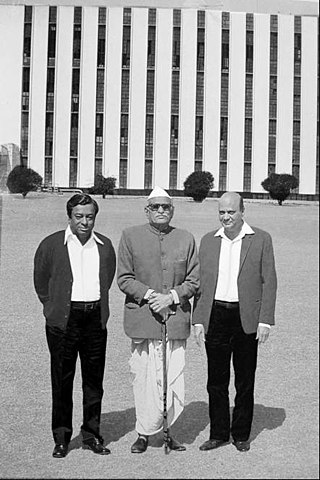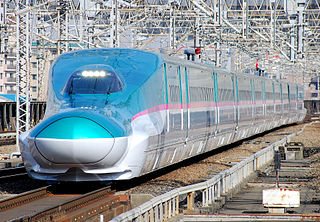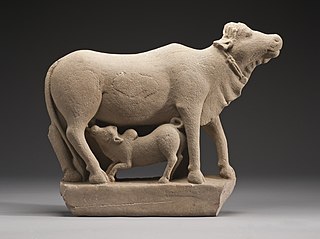
Goregaon ([ɡoːɾeɡaːʋ]) is a suburb of Mumbai city, in the Mumbai Suburban district of India. It has a railway station on the Mumbai suburban railway on the Western Line. An extension of the Harbour Line was completed in 2018 because of which it has regular trains to CSMT on the Harbour line. This is in addition to existing trains to Churchgate on the Western Line. Owing to the rapid urbanization and growing population of metropolitan Mumbai, Goregaon, which was once merely a hilly forest region is now a crowded suburb of Mumbai.

The Mumbai Metro is a rapid transit (MRT) system serving the city of Mumbai and the wider Mumbai Metropolitan Region in Maharashtra, India.

Sanjay Gandhi National Park is an 87 km2 (34 sq mi) protected area in Mumbai, Maharashtra. It was established in 1969 with its headquarters situated at Borivali.

White Revolution or Operation Flood, launched on 13 January 1970, was the world's largest dairy development program and a landmark project of India's National Dairy Development Board (NDDB). It transformed India from a milk-deficient nation into the world's largest milk producer, surpassing the United States in 1998 with about 22.29 percent of global output in 2018. Within 30 years, it doubled the milk available per person in India and made dairy farming India's largest self-sustainable rural employment generator. The program was launched to help farmers direct their own development, and to give them control of the resources they create.

Oshiwara River is a river in Mumbai, India. It begins in the Aarey Milk Colony, cuts through the Goregaon hills, across the Aarey Milk Colony before emptying into the Malad Creek. On the way it is joined by another creek near Swami Vivekanand Road, before picking up industrial effluents and sewage while crossing the Oshiwara industrial estates and slums of Andheri. Most of the call centres in Malad have been built on reclaimed ground at the mouth of the river.
Marol is a locality in the suburb of the Andheri (East) in Mumbai, India.

Film City; officially Dadasaheb Phalke Chitranagari is an integrated film studio complex situated near Sanjay Gandhi National Park in Goregaon East, Mumbai in India. It has several recording rooms, gardens, lakes, theatres and grounds that serve as the venue of many Bollywood and Marathi films. It was built in 1977 by the state government to provide facilities and concessions to the film industry. The plan for Film City was prepared and executed under the guidance of V. Shantaram. It was renamed Dadasaheb Phalke Chitra Nagari in 2001 in memory of India's first producer-director-screenwriter Dadasaheb Phalke, who is considered as father of the Indian film industry. It has been the shooting location for almost all Bollywood films. It has many types of location available for shooting including permanent sets of a temple, prison, court, lake, mountains, fountains, villages, picnic spots, gardens and a man-made waterfall.
Ashwini Bhide is an Indian Administrative Service (IAS) officer, predominantly known for her work on the Aqua Line or popularly known as Line 3 of the Mumbai Metro. She served as Managing Director of Mumbai Metro Rail Corporation (MMRCL), which is a joint venture of the Government of India and Government of Maharashtra since its inception, i.e. 2015 until 2020.

Force One is a specialised counter terrorism unit of the Mumbai Police to guard the Mumbai metropolitan area, one of the largest metropolitan areas in the world, formed by the Government of Maharashtra on the lines of National Security Guards (NSG). It was formed under Maharashtra Police, as a response to the 2008 Mumbai terror attacks and was commissioned two days before its first anniversary at the time of establishment Shri Jayant Patil was State Home Minister of Maharashtra. On the occasion, Maharashtra Chief Minister Ashok Chavan also laid the foundation stone of the Force One's headquarters in Mumbai. One of the primary tasks of the unit will be to protect the Maharashtra Legislature as well as several politicians within the state.

Mumbai–Ahmedabad High Speed Rail Corridor (MAHSR) or Mumbai–Ahmedabad HSR is an under-construction high-speed rail line, which will connect Mumbai, the financial hub of India, with Ahmedabad, the largest city in the state of Gujarat. When completed, it will be India's first high-speed rail line.

Vanashakti is a non-profit environmental NGO based in Mumbai, Maharashtra. It was formed in 2006, by Meenakshi Menon, Namita Roy Ghose, and Peter Armand Menon. Vanashakti aims to conserve the forests, wetlands, wildlife corridors, habitats, through education and litigation to achieve its objectives of creating awareness about environmental topics, protecting and reviving rivers and preventing opencast mining in areas that are well-endowed with biodiversity. It also directs its efforts in involving local forest-dwelling communities to protect the biodiversity of the region and provides sustainable livelihood options for forest dependent and coastal communities. Vanashakti's thrust areas are forest, mangrove and wetland protection, environmental education for both urban and rural schools, livelihoods for forest based communities and scientific investigation into local environmental degradation.
Line 3 (Aqua Line) of the Mumbai Metro is a rapid transit metro line in the city of Mumbai, Maharashtra, India. When completed, the 33.5 km (20.8 mi) long line will be the first underground metro line in Mumbai, with 27 underground stations and one at-grade station. The line will run from Navy Nagar in the far-south of Mumbai to Aarey Depot in the north-centre, and will include connections to other metro lines, monorail, suburban rail, inter-city rail, and Mumbai's International Airport. Line 3 is expected to reduce road congestion as well as the load on the Western Line between Bandra and Churchgate.

Line 2 (Yellow Line) of the Mumbai Metro is a rapid transit metro line in the city of Mumbai, Maharashtra, India. The line connects Dahisar in the northwest with Mandale in Mankhurd via Andheri, BKC and Chembur in the east. Phase One of Line 2A was partially opened on 2 April 2022 from Dahisar East to Dahanukarwadi.
Dara Nusserwanji Khurody was an Indian entrepreneur known for his contributions to the dairy industry of India. He worked in various private and government organization at the start of his career and also held government official positions later on. He was the Milk Commissioner of Bombay from 1946 to 1952. His name was considered "synonymous with dairying" in India in the 1950s. He received the Ramon Magsaysay Award jointly with Verghese Kurien and Tribhuvandas Kishibhai Patel in 1963 and the Padma Bhushan from the Government of India in 1964.
Line 7 (Red Line) of the Mumbai Metro is a rapid transit metro line in the city of Mumbai, Maharashtra, India. When completed, the 30.08 km (18.69 mi) line will connect Bhayander with the Chhatrapati Shivaji Maharaj International Airport with 24 stations. The line is mostly elevated except for the 2.49 km (1.55 mi) underground twin tunnels at its southern terminus.

Line 4 (Green Line) of the Mumbai Metro is an under-construction rapid transit line in Mumbai, Maharashtra, India.

Dairy plays a significant part in numerous aspects of Indian society, including cuisine, religion, culture, and the economy.

The Ministry of Housing is a ministry in the Government of Maharashtra. Ministry is responsible for implementation of laws and acts related to housing in Maharashtra.




















